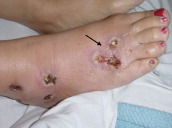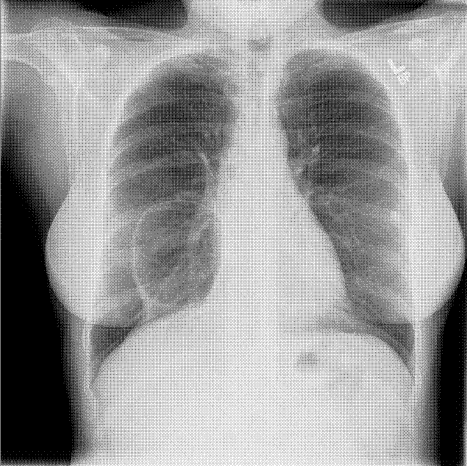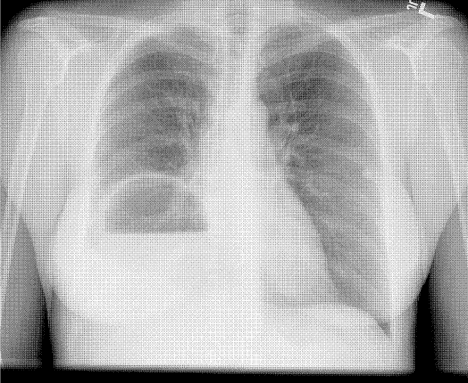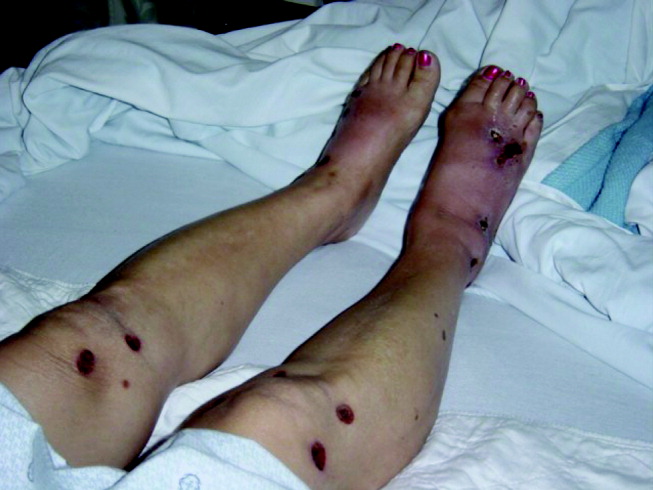User login
Moxibustion burns
A 53‐year‐old Korean woman was admitted to the hospital with a diagnosis of cellulitis (thin arrow) and rule out vasculitis. Further history obtained with the assistance of a Korean translator revealed that the patient, though untrained in Chinese medicine, had attempted scarring direct moxibustion for intermittent headaches. She was treated with intravenous antibiotics for 24 hours for her cellulitis and discharged in good condition on oral antibiotics.
Moxibustion is a traditional Chinese medical technique that involves burning the herb mugwort (Artemesia vulgaris) to relieve cold or stagnant conditions by stimulating circulation. Moxibustion can be performed indirectly or directly. Indirect moxibustion involves application of the burning moxa to the end of an acupuncture needle or by holding the moxa close to the skin. In direct moxibustion, a cone‐shaped moxa is held over an acupuncture point. Direct moxibustion can be divided into scarring and nonscarring types. With nonscarring direct moxibustion, moxa is placed on top of an acupuncture point, lit, and then removed before it burns the skin. With scarring moxibustion, the burning moxa is left on the skin until it burns out, leading to burns and scarring.
This case demonstrates the importance of obtaining an accurate history when making a clinical diagnosis and, in patients who are not fluent in English, the critical role that translators serve in the management of patients. The differential diagnosis of skin ulcers encompasses many other conditions in addition to infection, including iatrogenic causes of traditional as well as alternative medical therapies. 0


A 53‐year‐old Korean woman was admitted to the hospital with a diagnosis of cellulitis (thin arrow) and rule out vasculitis. Further history obtained with the assistance of a Korean translator revealed that the patient, though untrained in Chinese medicine, had attempted scarring direct moxibustion for intermittent headaches. She was treated with intravenous antibiotics for 24 hours for her cellulitis and discharged in good condition on oral antibiotics.
Moxibustion is a traditional Chinese medical technique that involves burning the herb mugwort (Artemesia vulgaris) to relieve cold or stagnant conditions by stimulating circulation. Moxibustion can be performed indirectly or directly. Indirect moxibustion involves application of the burning moxa to the end of an acupuncture needle or by holding the moxa close to the skin. In direct moxibustion, a cone‐shaped moxa is held over an acupuncture point. Direct moxibustion can be divided into scarring and nonscarring types. With nonscarring direct moxibustion, moxa is placed on top of an acupuncture point, lit, and then removed before it burns the skin. With scarring moxibustion, the burning moxa is left on the skin until it burns out, leading to burns and scarring.
This case demonstrates the importance of obtaining an accurate history when making a clinical diagnosis and, in patients who are not fluent in English, the critical role that translators serve in the management of patients. The differential diagnosis of skin ulcers encompasses many other conditions in addition to infection, including iatrogenic causes of traditional as well as alternative medical therapies. 0


A 53‐year‐old Korean woman was admitted to the hospital with a diagnosis of cellulitis (thin arrow) and rule out vasculitis. Further history obtained with the assistance of a Korean translator revealed that the patient, though untrained in Chinese medicine, had attempted scarring direct moxibustion for intermittent headaches. She was treated with intravenous antibiotics for 24 hours for her cellulitis and discharged in good condition on oral antibiotics.
Moxibustion is a traditional Chinese medical technique that involves burning the herb mugwort (Artemesia vulgaris) to relieve cold or stagnant conditions by stimulating circulation. Moxibustion can be performed indirectly or directly. Indirect moxibustion involves application of the burning moxa to the end of an acupuncture needle or by holding the moxa close to the skin. In direct moxibustion, a cone‐shaped moxa is held over an acupuncture point. Direct moxibustion can be divided into scarring and nonscarring types. With nonscarring direct moxibustion, moxa is placed on top of an acupuncture point, lit, and then removed before it burns the skin. With scarring moxibustion, the burning moxa is left on the skin until it burns out, leading to burns and scarring.
This case demonstrates the importance of obtaining an accurate history when making a clinical diagnosis and, in patients who are not fluent in English, the critical role that translators serve in the management of patients. The differential diagnosis of skin ulcers encompasses many other conditions in addition to infection, including iatrogenic causes of traditional as well as alternative medical therapies. 0


Infected pneumatocele
A 49‐year‐old woman with a history of asthma and a pneumatocele secondary to a past pneumonia (Fig. 1, prior baseline chest X‐ray) presented with fever, cough, and shortness of breath. This was her third admission for similar symptoms. In the past, these symptoms had resolved with antibiotics and percutaneous drainage of the infected pneumatocele. Her admission chest X‐ray revealed a fluid‐filled pneumatocele (Fig. 2). Given the recurrent nature of her disease, a right middle lobectomy was performed. Her recovery after surgery was uneventful, and she continues to do well 4 months later.


Pneumatoceles are air‐filled cysts that occur because of trauma or inflammation in the lung parenchyma. The most common cause is pneumonia and they occur most frequently in children. Complications of pneumatocele include pneumothorax and, as in this patient, secondary infection. In most instances the pneumatocele resolves after treating the underlying pneumonia, but surgical intervention is sometimes required to have a definitive cure.
A 49‐year‐old woman with a history of asthma and a pneumatocele secondary to a past pneumonia (Fig. 1, prior baseline chest X‐ray) presented with fever, cough, and shortness of breath. This was her third admission for similar symptoms. In the past, these symptoms had resolved with antibiotics and percutaneous drainage of the infected pneumatocele. Her admission chest X‐ray revealed a fluid‐filled pneumatocele (Fig. 2). Given the recurrent nature of her disease, a right middle lobectomy was performed. Her recovery after surgery was uneventful, and she continues to do well 4 months later.


Pneumatoceles are air‐filled cysts that occur because of trauma or inflammation in the lung parenchyma. The most common cause is pneumonia and they occur most frequently in children. Complications of pneumatocele include pneumothorax and, as in this patient, secondary infection. In most instances the pneumatocele resolves after treating the underlying pneumonia, but surgical intervention is sometimes required to have a definitive cure.
A 49‐year‐old woman with a history of asthma and a pneumatocele secondary to a past pneumonia (Fig. 1, prior baseline chest X‐ray) presented with fever, cough, and shortness of breath. This was her third admission for similar symptoms. In the past, these symptoms had resolved with antibiotics and percutaneous drainage of the infected pneumatocele. Her admission chest X‐ray revealed a fluid‐filled pneumatocele (Fig. 2). Given the recurrent nature of her disease, a right middle lobectomy was performed. Her recovery after surgery was uneventful, and she continues to do well 4 months later.


Pneumatoceles are air‐filled cysts that occur because of trauma or inflammation in the lung parenchyma. The most common cause is pneumonia and they occur most frequently in children. Complications of pneumatocele include pneumothorax and, as in this patient, secondary infection. In most instances the pneumatocele resolves after treating the underlying pneumonia, but surgical intervention is sometimes required to have a definitive cure.

